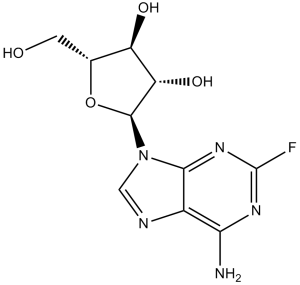This product is for research use only, not for human use. We do not sell to patients.

| Size | Price | Stock |
|---|---|---|
| 1g | $645 | Check With Us |
| 2g | $980 | Check With Us |
| 5g | $1470 | Check With Us |
Cat #: V1379 CAS #: 21679-14-1 Purity ≥ 98%
Description: Fludarabine (also known as FaraA, Fludarabinum; NSC-118218; F-ara-A, HSDB6964; NSC118218; HSDB-6964) is a potent STAT1 activation inhibitor and a DNA synthesis inhibitor that has been approved as a chemotherapeutic drug for the treatment of leukemia and lymphoma.
Publications Citing InvivoChem Products
Product Promise

- Physicochemical and Storage Information
- Protocol
- Related Biological Data
- Stock Solution Preparation
- Quality Control Documentation
| Molecular Weight (MW) | 285.23 |
|---|---|
| Molecular Formula | C10H12FN5O4 |
| CAS No. | 21679-14-1 |
| Storage | -20℃ for 3 years in powder formrr |
| -80℃ for 2 years in solvent | |
| Solubility In Vitro | DMSO: 57 mg/mL (199.8 mM)rr |
| Water: <1 mg/mLrr | |
| Ethanol: <1 mg/mL | |
| Solubility In Vivo | 30% propylene glycol, 5% Tween 80, 65% D5W: 30 mg/mL |
| Synonyms | FaraA, Fludarabinum; HSDB 6964; F-ara-A, HSDB6964; NSC118218; HSDB-6964; NSC 118218; F-ara A, NSC-118218 |
| Protocol | In Vivo | Fludarabine (0.8 mg/kg; i.p.; two cycles for 5 days every 2 weeks) in combination with Cyclophosphamide (400 mg/kg; i.p.; 2 weeks) decreases incidence of GVHD |
|---|---|---|
| Animal model | ||
| Formulation | F-1 mice received 105 BCL-1 leukemia cells | |
| Dosages | 0.8 mg/kg | |
| Administration | Intraperitoneal injection; two cycles for 5 days every 2 weeks |
| Solvent volume to be added | Mass (the weight of a compound) | |||
|---|---|---|---|---|
| Mother liquor concentration | 1mg | 5mg | 10mg | 20mg |
| 1mM | 3.5059 mL | 17.5297 mL | 35.0594 mL | 70.1189 mL |
| 5mM | 0.7012 mL | 3.5059 mL | 7.0119 mL | 14.0238 mL |
| 10mM | 0.3506 mL | 1.7530 mL | 3.5059 mL | 7.0119 mL |
| 20mM | 0.1753 mL | 0.8765 mL | 1.7530 mL | 3.5059 mL |
This equation is commonly abbreviated as: C1 V1 = C2 V2
- (1) Please be sure that the solution is clear before the addition of next solvent. Dissolution methods like vortex, ultrasound or warming and heat may be used to aid dissolving.
- (2) Be sure to add the solvent(s) in order.




































